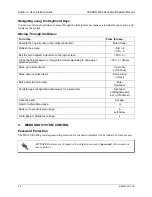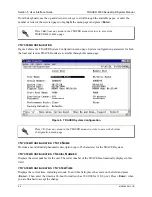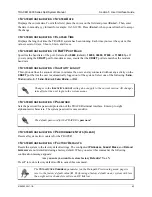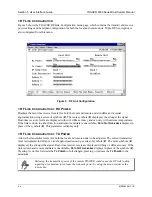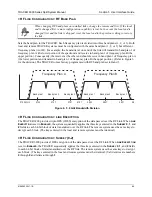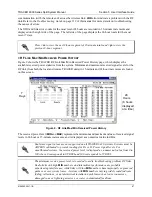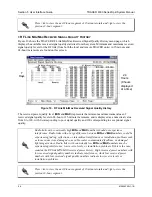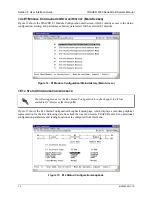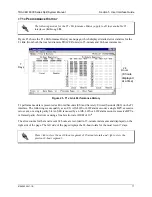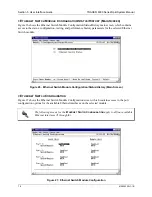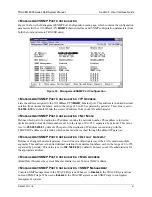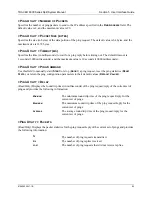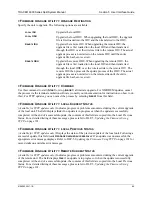
TRACER 6000 Series Split System Manual
Section 5 User Interface Guide
612806320L1-1B
71
> E1
X
S
TATUS
/C
ONFIGURATION
/L
OOPBACK
> E1
X
I
NTERFACE
A
LARMS
Displays any active alarms on the E1 link (reported from both the local and remote TRACER units).
These alarms include AIS, CRC, LCV, LOS, OOF, and RMT. Table 1 briefly describes these alarms. See
Section 6,
Troubleshooting Guide
, on page 119, for more information on these alarms.
> E1
X
S
TATUS
/C
ONFIGURATION
/L
OOPBACK
> I
NTERFACE
T
YPE
(Read Only) Displays the current interface type of the E1 module as either
75 O
HM
or
120 O
HM
.
> E1
X
S
TATUS
/C
ONFIGURATION
/L
OOPBACK
> A
LARM
R
EPORTING
Determines whether the TRACER unit will report active alarms. If set to
D
ISABLED
, no alarms will be
displayed on this menu page. The
A
LARM
R
EPORTING
parameter is independently configured for the local
and remote TRACER units. When set to
D
ISABLED
, the TRACER does not report active alarms via SNMP,
the
CRAFT
port, alarm contacts, menu screens, or LEDs on the front panel. By default, alarm reporting is
set to
E
NABLED
.
> E1
X
S
TATUS
/C
ONFIGURATION
/L
OOPBACK
> CRC4 D
ETECTION
When
E
NABLED
, the receiver detects the CRC-4 checksum bits in the outgoing E1 data stream and checks
the received signal for errors.
> E1
X
S
TATUS
/C
ONFIGURATION
/L
OOPBACK
> S
IGNALING
Configures the framing format for the E1 link. The TRACER transports E1 data across the link (as long as
the E1 signal is properly timed). Configure the framing format (using the
S
IGNALING
menu) to enable the
TRACER to monitor incoming framing error events and indicate problems with the attached metallic
service. The TRACER supports
M
ULTIFRAMED
(also known as CAS),
U
NFRAMED
(all data stream with no
framing sequence bits), and
F
RAMED
(also known as CCS). The default value is
F
RAMED
.
> E1
X
S
TATUS
/C
ONFIGURATION
/L
OOPBACK
> L
INE
C
ODE
Sets the line coding for the E1 link. The TRACER supports high-density bipolar 3 substitution (
HDB3
) and
alternate mark inversion (
AMI
) line coding. HDB3 coding does not allow more than three consecutive
zeros in a transmitted bit stream and is the standard coding method on public networks.
Table 1. E1 Interface Alarms
AIS
(Alarm Indication Signal) Activates when an incoming remote alarm is received from a
connected E1 device. An AIS signal is an unframed all one signal that replaces the normal
traffic signal.
CRC
(Loss of CRC-4 Framing) The receiver is unable to synchronize to the CRC-4 frame
pattern of the received signal.
LCV
(Line Code Violations) Activates when the incoming E1 stream presents line coding
violations.
LOS
(Loss of Signal) Activates when no E1 signal is present from the connected E1 equipment.
LOS is activated after receiving 192 consecutive zeros.
OOF
(Out of Frame) The receiver is unable to synchronize to the FAS framing pattern of the
received signal.
RMT
(Received Remote Alarm) Activates when an incoming remote alarm is received from the
E1 device, indicating that a failure has occurred in the received direction.


